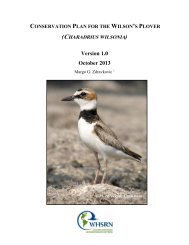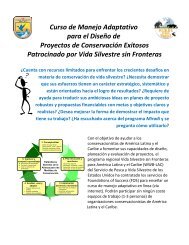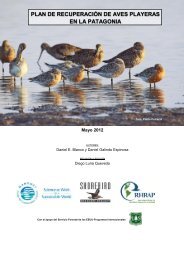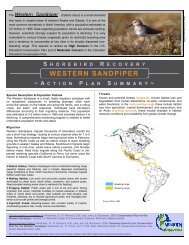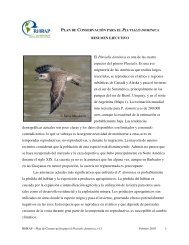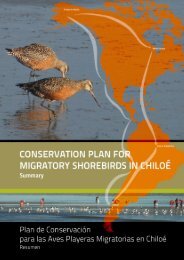Sanderling Plan - Western Hemisphere Shorebird Reserve Network
Sanderling Plan - Western Hemisphere Shorebird Reserve Network
Sanderling Plan - Western Hemisphere Shorebird Reserve Network
Create successful ePaper yourself
Turn your PDF publications into a flip-book with our unique Google optimized e-Paper software.
New Jersey; the Outer Banks of North Carolina; and the Washington coast. Recommendations<br />
made in Version 1.0 of this document are based mainly on the International <strong>Shorebird</strong> Survey<br />
data scheme (emphasis on United States) and, as such, are incomplete. Future versions of this<br />
<strong>Sanderling</strong> Conservation <strong>Plan</strong> will expand geographically to include other data sets for a more<br />
comprehensive perspective.<br />
In response to the recognized need for standardized survey efforts, the Program for<br />
Regional and International <strong>Shorebird</strong> Monitoring (PRISM) was launched as the blueprint for<br />
shorebird monitoring efforts in the United States and Canada. It is intended to provide reliable<br />
information on the distribution, abundance, and population trends of shorebirds. A top priority<br />
for <strong>Sanderling</strong> conservation continues to be to improve monitoring schemes, in order to enable<br />
robust estimates of population trends; PRISM is a crucial (and substantial) step in that direction,<br />
although it does not replace existing schemes (i.e., ISS). However, ideally, other sites should<br />
continue to be monitored (albeit in a more standardized fashion) to supplement PRISM efforts<br />
and to provide wider coverage throughout the nonbreeding range.<br />
An option that merits consideration is to organize and refocus non-PRISM monitoring<br />
efforts (such as ISS, or other) to incorporate a rotating panel design. In such a design, a set<br />
number of ‘key’ sites are monitored every year, and additional rotating sets are identified for<br />
monitoring at lower frequencies (e.g., every few years). Such a set-up would require greater<br />
logistical investment up front (to coordinate participant efforts), but once up and running, would<br />
offer critical improvements over the current (non-PRISM) set-ups, because it would provide<br />
consistent sampling in space and time, increasing confidence in both population trend analysis<br />
and the identification of important sites.<br />
CONSERVATION TIMELINE<br />
By 2010<br />
• Create a <strong>Sanderling</strong> Working Group that includes participants from across the <strong>Western</strong><br />
<strong>Hemisphere</strong>;<br />
• Develop a plan to revisit and evaluate ISS sites that were important to the <strong>Sanderling</strong> at<br />
some point in the past, but have not been surveyed since the 1990s;<br />
WHSRN – <strong>Sanderling</strong> Conservation <strong>Plan</strong>, February 2010, v1.1 66





